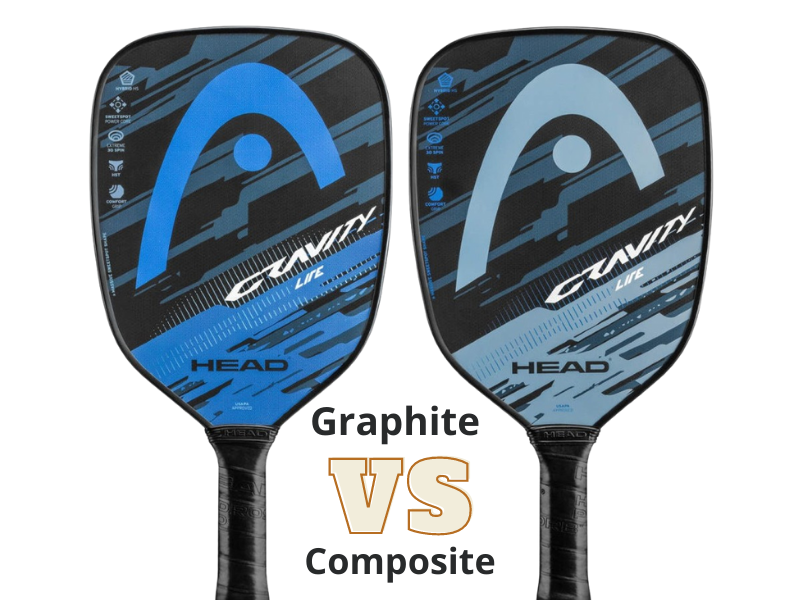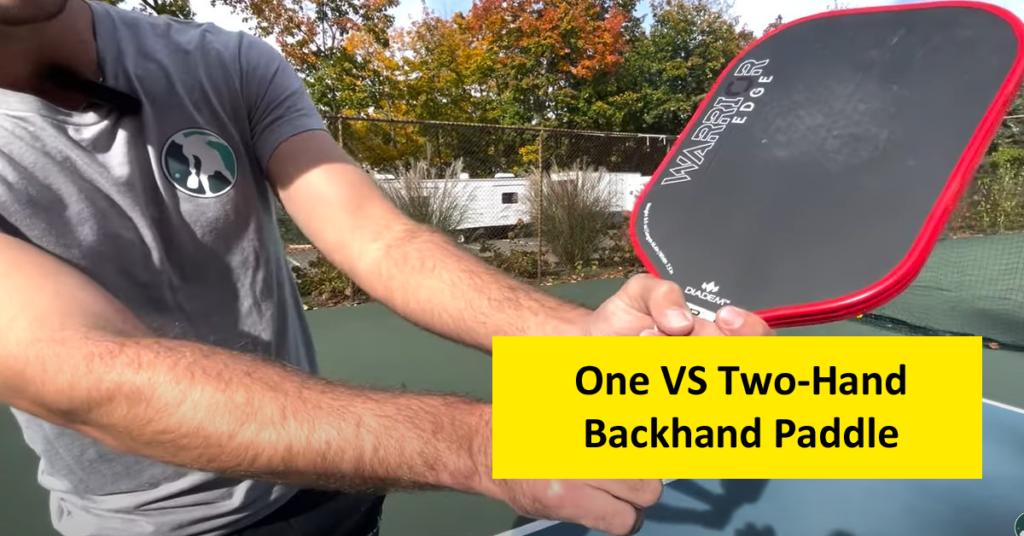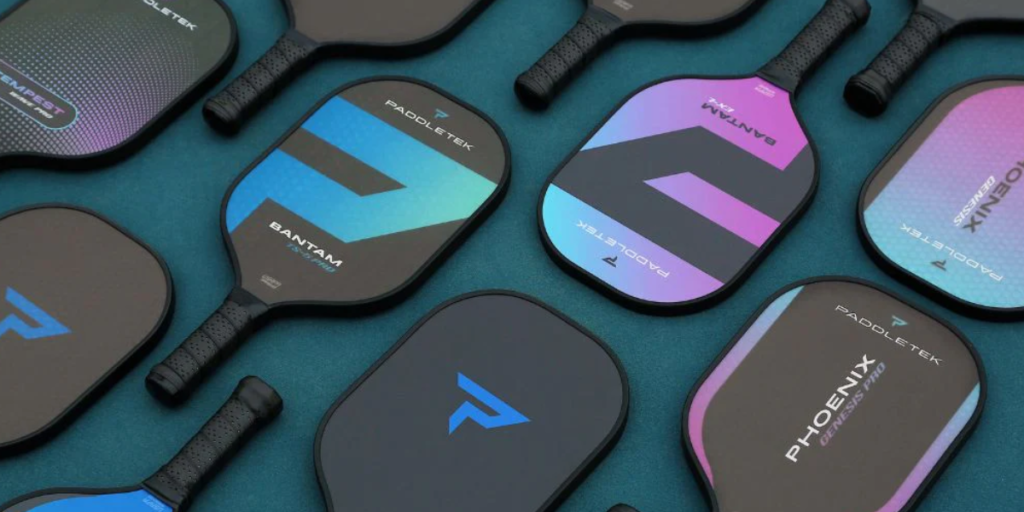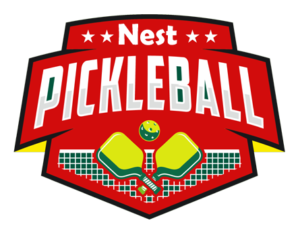This blog covers all aspects of the game of pickleball vs racquetball. Topics include equipment, court dimensions, rules, scoring, play, and more. You’ll find much information about the sport on this blog too.
But, what is the quick difference between Pickleball and racquetball? and what are the similarities? There are many similarities between the two games, including the net and equipment, but key differences exist.
Pickleball and racquetball are both racquet sports, but they possess distinct differences that cater to various player preferences and skills. You can play pickleball on a smaller court, similar to a badminton court, using a paddle and a perforated ball. The rules and gameplay bear some resemblance to tennis, but with unique serving and scoring methods, and it can be played both indoors and outdoors. On the other hand, racquetball is played in a fully enclosed court, and participants use stringed racquets to hit a hollow rubber ball. The objective in racquetball is to keep the ball in continuous play until one player misses a shot or hits it out of bounds.
What’s the Difference Between Racquetball and Pickleball?
While both racquetball and pickleball fall under the umbrella of racquet sports, they are quite distinct in their gameplay, equipment, and court specifications.
The recent surge in pickleball’s popularity, especially among former tennis players and those seeking a less physically demanding sport, contrasts with the once widespread popularity of racquetball.
Let’s delve into the key differences between these two sports:
1. Court Design and Size
- Racquetball: Racquetball is played in an enclosed court measuring 40 feet long, 20 feet wide, and 20 feet high. The game involves playing off the walls, ceiling, and floor.
- Pickleball: Pickleball, on the other hand, is played on a smaller, badminton-sized court (20 feet wide and 44 feet long). Unlike racquetball, it’s an open court with a net similar to tennis, but with specific non-volley zones known as the kitchen.
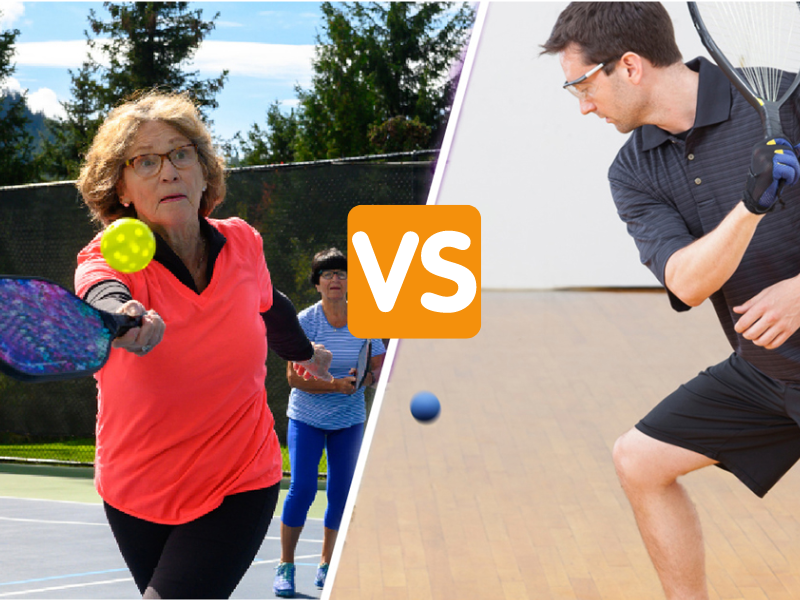
2. Equipment Used
- Racquetball: This sport utilizes a stringed racquet, typically smaller and more solid than a tennis racquet, and a small, bouncy rubber ball.
- Pickleball: Pickleball players use solid paddles, which are larger than table tennis paddles but smaller than tennis racquets. The ball used in pickleball is similar to a wiffle ball, with holes through it.
3. Rules and Style of Play
- Racquetball: Racquetball can involve a lot of running and quick turns, as players hit the ball after it bounces off walls. The game’s objective is to hit the ball in such a way that the opponent cannot return it.
- Pickleball: Pickleball combines elements of tennis, badminton, and table tennis. The ball is hit over a net, and points can only be scored by the serving side. The non-volley zone in pickleball prohibits players from volleying the ball near the net, adding a unique strategic element.
4. Physical Intensity and Accessibility
- Racquetball: It is a high-energy, fast-paced game requiring significant physical agility and endurance. The enclosed court makes for a more intense and aggressive play style.
- Pickleball: Pickleball is generally easier on the body, making it a popular choice for older players or those seeking a sport with less physical strain. The rules and court size promote strategic play over physical prowess.
5. Popularity and Social Aspect
- Racquetball: While still played, racquetball’s popularity has waned compared to its peak in the late 20th century.
- Pickleball: Currently experiencing a surge in popularity, pickleball is known for its social aspect, often being more accessible and family-friendly.
Pickleball Paddles VS Racquetball Racquets
When I’m at the gym, I have to decide which of these two games I should play. I usually prefer racquetball because of the more challenging game. Also, playing with racquetballs gives me more muscle fatigue than playing with pickleballs. But, what’s the difference between racquetball and squash?
However, I recently discovered that picking up a pickleball paddle was an easier transition to playing pickleball. I will share my reasons as to why pickleball paddles are easier to pick up and how they help me improve in pickleball.
Racquetball VS Pickleball
Pickleballs are balls similar in appearance to tennis balls. They’re generally softer than tennis balls and don’t bounce well. Pickleballs are used in pickleball games, which are similar to badminton games.
While racquetballs are harder than tennis balls and bounce higher. They’re commonly used in racket sports like racquetball, badminton, squash, table tennis, and paddleball.
Pickleballs and racquetballs differ significantly in their design, material, and purpose. Here’s a comparison between the two:
Pickleball
- Material: Typically made of durable plastic.
- Appearance: They are perforated with numerous holes.
- Diameter: Generally around 2.87 to 2.97 inches (7.3 to 7.5 cm).
- Weight: They weigh between 0.78 and 0.935 ounces (22 to 26.5 grams).
- Bounce: In standard testing, pickleballs bounce between 30 to 34 inches when dropped from a height of 78 inches.
- Usage: Designed for outdoor and indoor play, pickleballs are structured to be wind-resistant and are typically less affected by environmental factors.
Racquetballs
- Material: Made of rubber.
- Appearance: Solid, without any holes, and often blue or green (though other colors exist).
- Diameter: Approximately 2.25 inches (5.7 cm).
- Weight: They weigh around 1.4 ounces (40 grams).
- Bounce: Racquetballs have a higher bounce due to their rubber material.
- Usage: Designed primarily for indoor play in enclosed courts, racquetballs are more bouncy and faster-moving compared to pickleballs.
Pickleball Courts VS Racquetball Courts
The racquetball court has an open area in the center. This area is also known as the service box or the middlebox. On the other side, the pickleball court has a covered service box where the ball must bounce before being hit. In most cases, the service box of a pickleball court is not very large and does not cover half the court.

However, the pickleball and racquetball courts dimensions are differ which we have mentioned here.
Pickleball Courts
- Size: The official court dimensions for pickleball are 20 feet wide by 44 feet long for both singles and doubles.
- Net Height: The net height is 36 inches at the sidelines and 34 inches in the middle.
- Non-Volley Zone (Kitchen): This area extends 7 feet from the net on both sides and is a zone where players cannot volley the ball; they must let it bounce once if they are standing in this area.
- Serving Areas: There are right and left serving areas, each 10 feet wide and 15 feet long, delineated by a centerline.
Racquetball Courts
- Size: The standard racquetball court is rectangular, with dimensions of 20 feet wide, 40 feet long, and 20 feet high.
- Front Wall: Players must hit the ball onto this wall on serves and during general play. It must cross a service line, which is 5 feet from the floor, but not touch the floor before the short line, which is halfway down the court (20 feet from the front wall).
- Service Boxes: There are two service boxes, one on each side of the court, where the server must stand during the serve.
- Back Wall: The ball can hit this wall during play, but on the serve, it shouldn’t touch it before bouncing once.
- Ceiling: The ball can touch the ceiling, but on the serve, it cannot hit the ceiling before hitting the front wall.
- Side Walls: These walls are used strategically to angle shots during matches.
Pickleballs and Racquetballs Comparison Chart
So you have two different kinds of balls: one with holes (like a toy ball you might play with outside) called a “pickleball,” and another solid, bouncy ball (like a super bouncy toy ball) called a “racquetball.”
The one with holes is used for a game that’s a mix of tennis and ping pong, and you play it in a big open pickleball court space or even inside. The super bouncy ball is used for a fast game inside a closed room where the ball can bounce off the walls. Both games are fun, but they’re played differently and use different kinds of balls.
So, here are the comparisons you can major the key feature differences between racquetball and pickleball.
| Feature | Pickleballs | Racquetballs |
|---|---|---|
| Material | Durable plastic | Rubber |
| Appearance | Perforated with holes | Solid, no holes |
| Diameter | 2.87 to 2.97 inches (7.3 to 7.5 cm) | Approx. 2.25 inches (5.7 cm) |
| Weight | 0.78 to 0.935 ounces (22 to 26.5 grams) | Approx. 1.4 ounces (40 grams) |
| Bounce | 30 to 34 inches from a 78-inch drop | Higher bounce due to rubber material |
| Usage Environment | Both outdoor and indoor | Primarily indoor |
| Speed | Moderate, impacted by wind in outdoor settings | Fast-paced, consistent in enclosed courts |
FAQs
Is pickleball similar to racquetball?
They’re both team sports played with a ball. Pickleball can be played with four players on each side, while racquetball can play with two. Pickleball has three main contact points – a rubber ball, a paddle, and a net. Racquetball has a hardball and a net.
Pickleball is a combination of tennis, table tennis, volleyball, and racquetball, and it’s played with similar equipment, but there are several differences between the two games. A pickleball player usually uses their hands rather than a racquet, and the ball bounces differently in a pickleball game than in a racquetball game.
Are racquetball players good at pickleball?
Racquetball players who switch to pickleball don’t have to deal with as much physical contact as in racquetball and, therefore, are better at it. They also play on more open courts, which allows for more room for strategic shots.
Why is racquetball not popular?
You might know why it isn’t popular in the tennis world, but racquetball is a very interesting sport. It’s a fast-paced game where you can choose to hit a ball back or across the court. Because you can only go one way, you’re constantly forced to move your body to cover more space.
Wrapping Up
Many think that racquetball and pickleball are the same, but they’re not. So are the pickleball and racquets the same? If not, what are the main differences between pickleball vs. Racquetball? The main difference between these sports is that pickleball scores more than racquetball. Also, the rules of racquetball are much stricter than those of pickleball.
Now, I am sure you’ve cleared everything about pickleball and racquetball. So decide the game, and let’s start playing!


